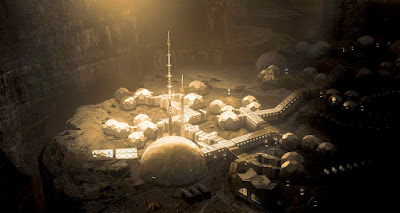Before the search for such evidence can begin there are practical issues that need to be addressed. Habitats with enough space and comfort are required to maintain the physical and mental health of the colonists. And such space and comfort should be ready and waiting even for the very first colonists to arrive. They will need decent quality homes, with enough comforts to get them through the months and years before they have the opportunity to return to Earth. Those habitats should be nothing less than a home from home.
There are plenty of designs for such habitats, but NASA's ice home concept is one of the more practical and impressive ones.
 |
| NASA's Mars ice home. The inside is inflated and then the outer shell filled with water. It can be constructed robotically and be ready when astronauts arrive. |
The home consists of an inflatable torus within which there are two levels of living space comparable to that of a small house on Earth. The torus is surrounded by chambers filled with ice to provide insulation and radiation protection. The water for the ice will be extracted from the subsurface ice that is abundant in many locations on Mars. Because of this the actual structure itself is very lightweight and can be deployed and build robotically. The homes would be delivered to Mars and prepared over the span of a year or so. When humans finally arrive they'll be able to move immediately into comfortable habitats.
 |
| A cross-section of NASA's ice home showing the interior space |
Whatever the design of the house, its interior should offer the ocupants the comforts of a home on Earth. It should be a familiar and safe place to return to, with space to relax and have privacy when required.
The first humans visiting Mars will almost certainly face a stay of at least a couple of months, and possibly a year or two. And that would be after many months of arduous travel in a cramped spacecraft. It is vital that those humans are provided with all the normal comforts possible to allow them to recover physically and mentally: essential for them to do their work effectively, and also for them to prepare for their return journey.
 |
| The interior of a house on Mars should offer all the comforts of a home on Earth. It should be spacious, clean, bright, and be familiar and cosy. |
Such homes should last many years, and be ideal for the early missions. But ultimately they would be temporary. One day people will arrive on Mars who will never leave. And soon after that the first children will be born there. By that time a substantial and permanent habitat will need to have been constructed.
The best place for permanent homes is below ground, or inside hills and mountains. Excavating such facilities from scratch would be an immense undertaking, but utilising existing underground chambers, such as lava tubes, would reduce the workload significantly. Homes for thousands could be build in such tubes, and the thick shielding required by surface habitats would not be necessary as the roof of the tube would be more than adequate.
 |
| A colony set up in the relative safety of a lava tube on Mars |
As well as exploiting natural underground voids such as lava tubes, there is the possibility to exploit unnatural voids, too (see my previous articles 'Sanctuary Entrance Found on Mars' and 'Where Did All the Martians Go?'). The search for such 'unnatural' voids is, in my opinion, one of the two primary reasons for sending humans to Mars (the other being, of course, to aid in the survival of our species if and when a global catastrophe occurs on Earth).
There is strong evidence to suggest that Mars was once a temperate world: one that could have been a perfect environment for life to thrive. That environment was likely to have existed for more than a billion years. That's more than enough time for an advanced civilisation to develop. For whatever reason that life-nourishing environment began to fail. It could not be saved. If there was a Martian civilisation it would have had no choice but to retreat underground (with a privileged few managing leaving the planet).
Eventually the underground civilisation would have died out.
Many of the vast chambers and warrens of tunnels they constructed must still remain, ready to be exploited when our civilisation arrives on the planet. There may be huge networks of structures and dwellings that could be modified for human habitation. Within just two centuries there could be a population of millions of humans living on Mars with complete independence from Earth.
When the first humans arrive on Mars and have their first colony up and running they must begin the search for those underground chambers. And from where better to embark on that search each day than a safe, spacious and pleasant home with all the familiar comforts of Earth.

